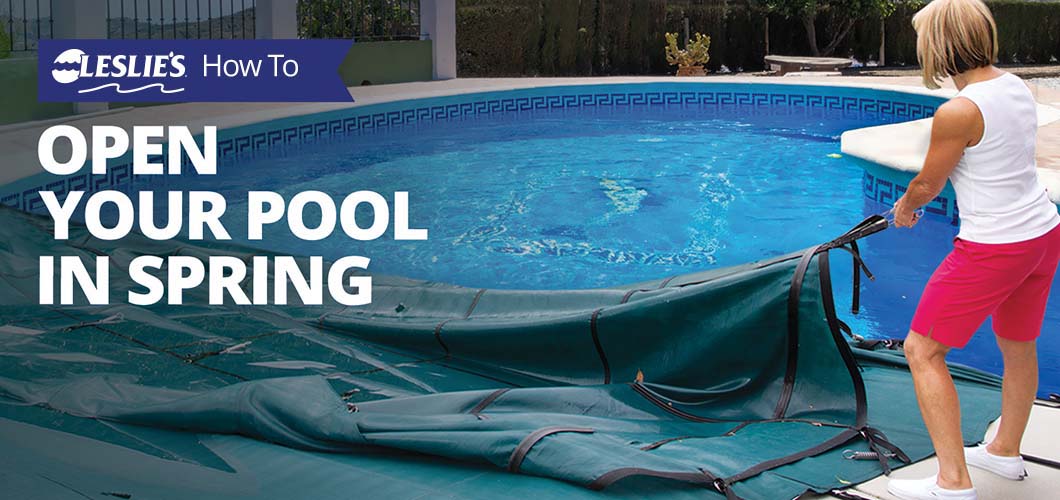
How to Open Your Pool in Spring
The arrival of spring means lots of our seasonal favorites — the beauty of blossoming plants and trees, longer-lasting sunshine, and warmer temperatures. For pool owners, spring’s arrival means it’s time to open your pool for the season! But just because the sun is shining doesn't mean the pool is ready for swimmers quite yet. With just a little effort, these steps will help you on your way to a clean, safe, and swim-ready pool.
When should you open your pool? If you’re wondering when is the right time to open an above ground pool or an inground pool, it all comes down to the weather. No matter what type of pool you have, we recommend opening the pool when daily high temperatures are consistently above 65–70ºF.
The steps to open your pool are listed below. Highlights include:
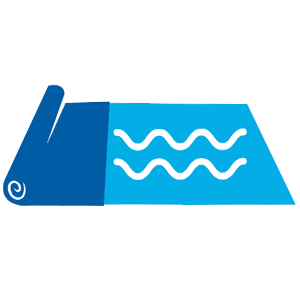
Removing and storing your pool cover
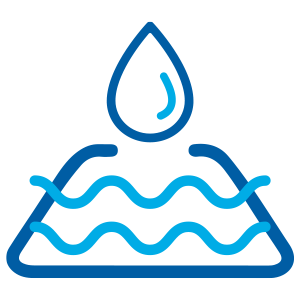
Refilling your pool to regular water levels
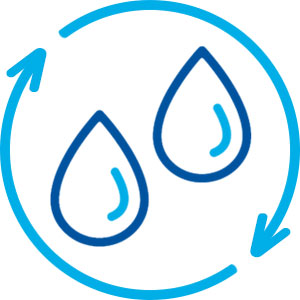
Turning on your pool equipment
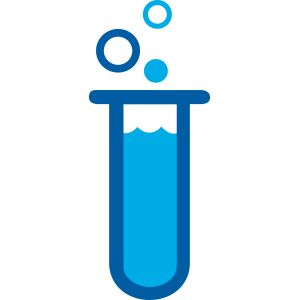
Testing and balancing your pool water

Shocking your pool
DIY TIP: Looking to simplify your pool opening process this year? Just purchase a Leslie's Pool Opening Kit! Each kit comes with all the essentials you'll need to treat your water when it's time to open the pool. In the kit, we’ve included pool shock, algaecide, clarifier, stain and scale prevention chemicals, and more. Just choose the right kit for your pool size, up to 35,000 gallons. For larger pools, use multiple kits.
1. Clean Off the Pool Cover
Whether you have a winter cover or solid safety cover, it's best to remove the extra water from the top of the cover before taking it off. If there is substantial water, you may want to use a cover pump or some type of siphon to do the work for you. Mesh covers allow water to drain through into the pool, so don't worry about this part if you have that type of cover. While the water is draining off, sweep off or scoop away all leaves and other debris on the cover. You don't want all that stuff landing in your pool when it's time to pull the cover back!
2. Remove the Pool Cover
It works best to have two people remove the cover, especially if you have a large pool. Try to prevent any remaining debris or dirty water from falling into the pool as you remove the cover. If a bit of debris ends up in the pool, that’s OK. You will still have to vacuum and shock the pool before you start swimming, anyway. But introducing extra debris and murky water into the pool will make the whole process a lot more difficult as you work to get it ready for swimming.
3. Clean and Store the Pool Cover
After you remove the cover, lay it out flat, brush off and rinse away any remaining debris, and then let it dry. If necessary, you can use a vinyl-safe cleaning product to help remove stuck-on dirt and debris. When the cover is completely dry, lightly sprinkle the cover with Leslie’s Alkalinity Up to prevent mold and mildew. Fold the cover loosely, and store it in a cool, dry place.
NOTE: If you did NOT winterize your pool for freezing conditions, skip ahead to Step 8.
4. Reconnect Pool Equipment
If you winterized your pool for freezing temperatures, you will need to get your pool equipment ready to operate again when you open the pool. This includes reinstalling drain plugs into your filter, pump, heater, and other equipment, as well as reconnecting anything you may have disconnected from the pool plumbing. For above ground pools, you will need to reconnect the flexible plumbing lines to the pool equipment and skimmer.
Now is also a great time to reinstall any ladders or handrails you removed at pool closing time.
5. Remove Winterizing Plugs from Skimmer and Return Lines
Don’t forget to remove all winterizing plugs from your skimmer and return lines. Now is the time to reconnect any return valves or eyeball fittings you removed last fall or winter. If you used non-toxic pool antifreeze at pool closing time, discharge it to waste or backwash the filter (if you have a sand or DE filter) once the pump is up and running. Alternatively, you can use a wet/dry shop vac to remove the antifreeze through the skimmer.
6. Raise the Water Level Back to Normal
Use a garden hose to fill the pool back to its normal water level. This is typically around the middle of the skimmer opening or halfway up the tile. Depending on how much water was removed at closing time, this may take a little while.
7. Turn the System Back On
Prime the pump so you can turn on the circulation and filtration system. If you have an air relief valve on your pool filter, open it to bleed the air from the system. Once water spurts out, close the air relief valve. Check all around the equipment pad for leaks or unusual noises. If you notice major issues, turn the system back off until you can make the necessary repairs.
BONUS TIP: Pump won't prime? You may have a leak. It's not uncommon for pool plumbing to spring a leak during the winter months, especially if water got into the suction or return lines during freezing weather. You may also want to check your pump lid to make sure it's not cracked and that the O-ring is in good shape. Check out our article on how to prime a pool pump to learn more.
8. Add Stain and Scale Prevention Chemicals
During the pool opening process, you'll want to leave your pump running continuously on high speed until you're all done, which could take a couple days in total. With the pump running, it's time to start adding chemicals!
After a long winter off-season, metals such as copper and iron may have concentrated in your pool water or fallen out of solution. When you open the pool, add Leslie's noMetal to prevent metals from causing stains or discoloration in your pool during the next steps. Or, if you purchased a Leslie's Pool Opening Kit, add the correct dose of Spring Stain Away. As with all pool chemicals, reference product label instructions for dosage and application details, and allow the water to circulate for at least 2–4 hours before moving to the next step.
Each week during swimming season, continue to use Leslie's Stain & Scale Prevent according to label directions. This will help avoid staining issues and scale buildup all summer long.
9. Test and Balance the Water
Once the circulation system has been running for a few hours, test your pool water for pH and Total Alkalinity with an at-home test kit or test strips. Ideal levels are as follows:
- pH: 7.4–7.6
- Total Alkalinity: 80–120 ppm
Don't worry about the rest of your water chemistry just yet — more on that in a bit. This step ensures your chlorine will work efficiently during the upcoming steps. Since pH and Total Alkalinity (TA) are closely tied together and use many of the same adjustment chemicals, it's important to balance TA levels first before addressing pH.
Total Alkalinity
Ideal TA levels depend on the type of primary sanitizer you're using. When using dichlor, trichlor, or bromine as your primary sanitizer, the ideal range is between 100–120 ppm. With cal-hypo or sodium hypochlorite (liquid chlorine), a level of 80–100 ppm is ideal. For salt systems, follow the manufacturer's recommendations for your unit.
If TA is too high, you can use Leslie’s Dry Acid to lower the levels to the ideal range. If TA is too low, add Leslie’s Alkalinity Up or Leslie's Soda Ash to increase TA levels in the water. Have questions? Check the label for dosage and application instructions, or read our other article for helpful tips on how to balance Total Alkalinity in your pool.
pH
Once the water has had time to circulate, you've retested the water, and the TA level is within the recommended range, it's then time to look at the updated pH so you know which way to adjust. The pH level should be between 7.4–7.6.
If the pH level is too high, use Leslie’s Dry Acid to bring it back down. On the other hand, if it's too low, use Leslie’s Soda Ash to bring it up. If you need help, we have a helpful article on how to balance pH, as well!
10. Brush and Vacuum the Pool
After adjusting your pool chemistry, thoroughly brush and vacuum your pool to remove any remaining dirt and debris. Pay special attention to places like pool steps, the waterline, and tight areas like corners and crevices.
11. Shock the Pool
Shocking the pool with chlorine will address any germs, algae, or other contaminants lurking in your water. If you purchased an Opening Kit from Leslie's, you can use the included bags of Chlor Brite.
Let the water circulate for at least 2 hours, then test the Free Available Chlorine level to make sure it's at least up to 1–4 ppm. A higher level is OK, but lower is not. If the level is still too low, continue adding more shock as needed to get the levels up. Just follow the product label for proper dosing instructions.
Now it's time to let the shock do its work. Leave the filter pump running on high, and let it run overnight. Your pool’s filtration system should remove much of the suspended dirt and debris left over after brushing and vacuuming your pool.
BONUS TIP: If you have an automatic pool cleaner, you can reinstall the cleaner 24 hours after shocking the pool, or whenever chlorine levels are back within the ideal range of 1–4 ppm.
12. Add Specialty Pool Chemicals
This is a good time for a reminder! It's extremely important to read and follow all pool chemical label instructions, especially as it relates to storage, handling, dosing, and post-application wait times before swimming or adding other chemicals. Remember to NEVER mix chemicals together or add multiple chemicals to the pool at the same time!
To finish getting your pool ready for swimming season, we recommend the following:
Clarifier
If you're having issues with cloudy water, an application of Leslie's Ultra Bright Advanced will coagulate even the smallest particles in your water. This makes it easier for your filter to trap the particles and remove them, boosting the efficiency of your filter to clear the water up faster.
Run the circulation system for at least 2–4 hours after adding the clarifier. Check the filter pressure occasionally, and clean the filter as necessary to keep it running efficiently. Particularly dirty pools may require an extra filter cleaning during the pool opening process.
Algae Control
The day after you shock the pool, add the recommended dosage of Leslie's Algae Control, and allow the circulation system to run for at least 2 hours. For Opening Kit users, add the proper dose of Opening Algaecide.
Enzymes
Enzymes work to break down non-living organic contaminants and oily residues, helping your sanitizer work more efficiently. Certain enzyme products, like those listed below, also contain phosphate removers to help fend off algae growth.
One popular enzyme product, especially during pool opening, is Pool Magic + Phosfree Spring and Fall. Add the proper amount into your skimmer while the pump is running. Your Free Chlorine level should be below 5 ppm before adding enzymes to the water. Especially at start-up, we recommend running the pump continuously for 48 hours after adding enzymes.
Once the pool is open, add a maintenance dose of Leslie's Perfect Weekly each week to help keep your pool water crystal clear all summer.
Download or print Leslie's Pool Opening Guide for quick and easy poolside reference.
Click HERE for your free copy!
13. Test and Balance the Water with Leslie's AccuBlue®
Making sure your water is healthy, sanitized, and ready for swimming is the last step in opening your pool. Once you've finished all the steps above, bring a water sample to your local Leslie's to take advantage of our free in-store AccuBlue® water test. You'll get a professional analysis for 10 different aspects of water chemistry to ensure your pool is perfectly balanced. If anything is out of range, you'll receive detailed step-by-step recommendations in a customized treatment plan to correct the issue and get your pool swim-ready.
Got Questions? Leslie's Has Answers.
Have questions, or need help? Leslie’s is the go-to resource for all your spring pool needs, including pool opening supplies. As mentioned above, using one of our specialized Pool Opening Kits can help make the opening and start-up process go smoothly, without the need to gather individual chemicals. These kits contain just the right amount of all the chemicals needed to open the pool and treat the water. It's a must-have item for clean, safe, and beautiful pool water at opening time.
If you are a new pool owner, or if you'd prefer someone else to open the pool for you, it's easy to schedule a pool opening service online or in store. Leslie’s certified service technicians are licensed and bonded Leslie’s employees — not third-party contractors — so you can be confident they're well-trained pool professionals. Our service techs can answer any pool care questions you might have, as well as provide tips to help get your pool in swim-ready condition. To learn more about Leslie's pool opening services, check out our Resource Center article or visit your local Leslie's.